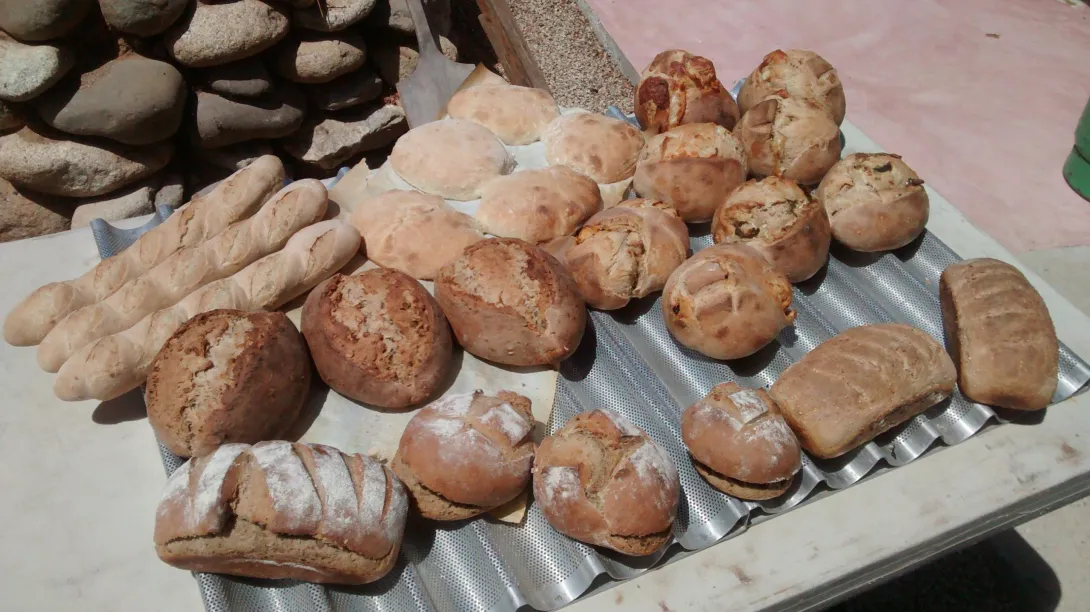
hi, my name is Seth and I have been running an artisanal bakery business in San Jose Del Cabo, Mexico for the past 4 years. I mostly have been selling at farmer's markets and at stores. I currently have a potential new client that wants rye sourdough for soup bowls. I'm having a hard time controlling oven spring to where it stays on the top. Here's a picture of today's bake . The 3 boules in the front left part are the rye sourdough and 1 is good but the others have split on a side. Almost all of the other breads have had nice spring. I've begun troubleshooting from some other forum posts. Made sure the dough was a good temperature after mixing, by using cold water. Its hot here so my ferment/proofing times are pretty quick, and am pretty sure it was not under proofed. Previously I had made the mistake of not heating up the stones enough, but not today. I had not been using enough steam so today I used the cast iron with a rag and boiling water method. but still maybe not enough.
the recipe for this dough was
360gr 100% hydration white sourdough
460gr white flour
540gr rye flour
530gr water
16gr sea salt
thanks for any ideas.
Hi, Seth.
So you are baking 46% rye breads at 60% hydration.
I get the impression you are baking in a wood-fired oven. Correct? in any case, you are not telling us the baking temperature or duration. Those would help.
What I can say is this:
1. What I see in your rye breads is bursting of the side walls. So expansion is occurring in that direction, rather than where you want it. Bursting is very common in rye breads. The best way of decreasing it is a) avoid under-proofing, b) avoid weak spots in the side walls, c) score or dock your loaves to create weak spots and control where loaf expansion happens, d) bake in a humid environment until the crust begins to form.
2. From the dull (not shiny) loaves, I would say you still aren't getting enough humidity. How you correct this depends some on the type of oven you have.
3. Although I don't think it directly speaks to your questions, most rye breads have all or a large part of the rye flour pre-fermented. This improves flavor, digestibility and prevents starch degradation/gummy crumb.
I hope these ideas are helpful.
David
anyways
oven temp was approx 450 and duration around 40 minutes (haven`t been timing this)
in the pic you can see the cast iron pan on the bottom level which was filled with hot water just after loading the upper levels.
Previously I had a seperate rye starter going, but a few months ago I had a gap in my rye flour supply so I put it to sleep, and since then have been using my white starter. From your comments, I plan to switch back.
thanks,
Seth
450 degrees (Fahrenheit I presume) sounds pretty low to me. I give my loaves five minutes at 290 degrees Centigrade, about 555 degrees Fahrenheit, before dropping the temperature to 220C (~430F) for the remainder of the bake. This produces excellent oven spring.
A higher initial temperature would help ensure that the spring happens before the crust forms, as well, preventing the splitting you're experiencing. I agree with the other posters' suggestion that more humidity would help there, too, as well as giving the loaves a more attractive finish.
Perhaps you need more than one pan of water to generate sufficient steam for your large oven compartments. After all, a home baker uses one pan of water to provide steam for one loaf in an ordinary home oven.
Other solutions are likely not practical for your large production. I use a la cloche, for example, though, perhaps, oblong la cloches would improve your steam situation as they do not take up much room and they provide an excellent steam environment in which oblong breads can bake.
Another idea, not having to do with steam, is to use pans to produce uniform-sized and shaped loaves. I instinctively wince at this suggestion because part of the charm of artisnal loaves is that they do not have a cookie cutter appearance. In fact, at a recommended wonderful bakery in Lucca, Italy, the bakery lacked any standard sizes for any of its breads. They were all beautiful, but their loveliness had nothing to do with consistent shaping and sizing from loaf to loaf.